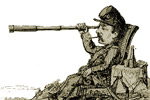
STOP #8
EMMITSBURG SIGNAL STATION |
There were at
least two signal stations located in Emmitsburg, one in the town and this one
located on the hill behind the college. There was flag signal communication
between this station and Little Round Top signal station from 2 July until 6
July, when it was purposely discontinued. The signal station in the church
steeple in Taneytown was not used heavily because it is somewhat
out of the way. However, it is mentioned in Norton's report and would make an
interesting side trip.
Report of Capt. Lemuel B. Norton, Chief Signal Officer, Army of the Potomac:
On the 30th, general headquarters removed to Taneytown. A signal
station was placed in the church steeple at that place, and a party sent to
Emmitsburg for the purpose of opening a line between General J.F. Reynolds and
headquarters. Communication was not opened this day on account of the haziness
of the atmosphere. The signal officer with General John Buford, who occupied
the town of Gettysburg, took position in the steeple of the college, and
reported to General Buford the whereabouts and movements of the enemy. The
offices attached to the First Corps, from a station of observation on the
mountain back of Emmitsburg, made a telescopic reconnaissance toward
Gettysburg, reporting the results to the general commanding that corps ...
... During the whole of this day [l July 1], endeavors were made to open
the signal line between general headquarters, Emmitsburg, and Round Top
Mountain, but on account of the smokiness of the atmosphere, the desired
result was not obtained until 11 p.m., when the first message was received.
These lines were kept open during the subsequent battle at Gettysburg and
until July 6. In the event of the repulse and retirement of our army, they
must have been eminently useful ....
On July 6, the lines between Round Top and Taneytown and Emmitsburg and
Taneytown were discontinued. The two officers attached to the First Corps made
a telescopic reconnaissance from the hill back of Emmitsburg, and sent the
information obtained to Maj. Gen. John Newton.
[O.R., XXVII, Part I, pp.201-203.]
As mentioned in the introduction, signal stations had two distinct purposes,
communications and observation. The station behind Mt. Saint Mary's College was
used for communications with Round Top but its primary purpose appears to have
been for observation. Col. Myer explains the observation function in his A
Manual of Signals:
The observations and reconnoissances made by signal officers
differ from those of other reconnoitering Officers, in the facts that, by
their long practice, they are able.to use their telescopes with an almost
wonderful skill; and that the information they gain can sometimes be compared
by them, from the place of observation, with that had at the same time by
other officers in view and watching the enemy from other points, by the
immediate transmission from one to the other of the facts noticed by each. The
reports of their reconnoissances can also, in many instances, at once be
communicated to the commanding general from the Diace at which the
observations are making, while the reconnoitering officer remains to add
further to his information. The reports are of a general character, relating
to the presence or movements of the enemy, etc., Such as are made by scouts.
They are not expected to embrace the specialties exhibited in a report of
engineers. An officer is often posted for weeks together at one station of
observation...
The principal station of observation ought to command a view of fords,
principal roads, railways, bridges, towns, camps, gaps in mountains, rivers,
ports, as the case may be, and generally of the routes of march or movement in
that section of the country ...
Observations of reconnaissance are generally made from several prominent
stations. They are to be briefly made, but they ought to be made with
scrupulous exactness. The parties moving with signal-officers on
reconnaissance are generally small. They should move with the utmost rapidity
and secrecy.
[Albert J. Myer, A Manual of Signals,
New York, D. Van Nostrand, 1866, pp.
360-362]
Now proceed to STOP 9.
Drive south on HWY 15 22.3 miles and exit on WEST 40. Drive 1.8 miles and
turn LEFT ON ALT 40. Drive 5.2 miles to MIDDLETOWN. There was a station located
in Middletown which was in flaa communication with the station on Washington
Monument. Although it is not documented. it was probably located in the Zion
Lutheran Church. The church was used as a hospital during the Antietam campaign
and based on the design of the steeple, was more than likely the site of the
Middletown signal station in July 1863. Continue on ALT 40 for 5.3 miles
stopping across from the OLD SOUTH MOUNTAIN INN. There is room to park by the
side of the road adjacent to a number of blue battlefield signs marking the
battle of TURNER'S GAP.
|




